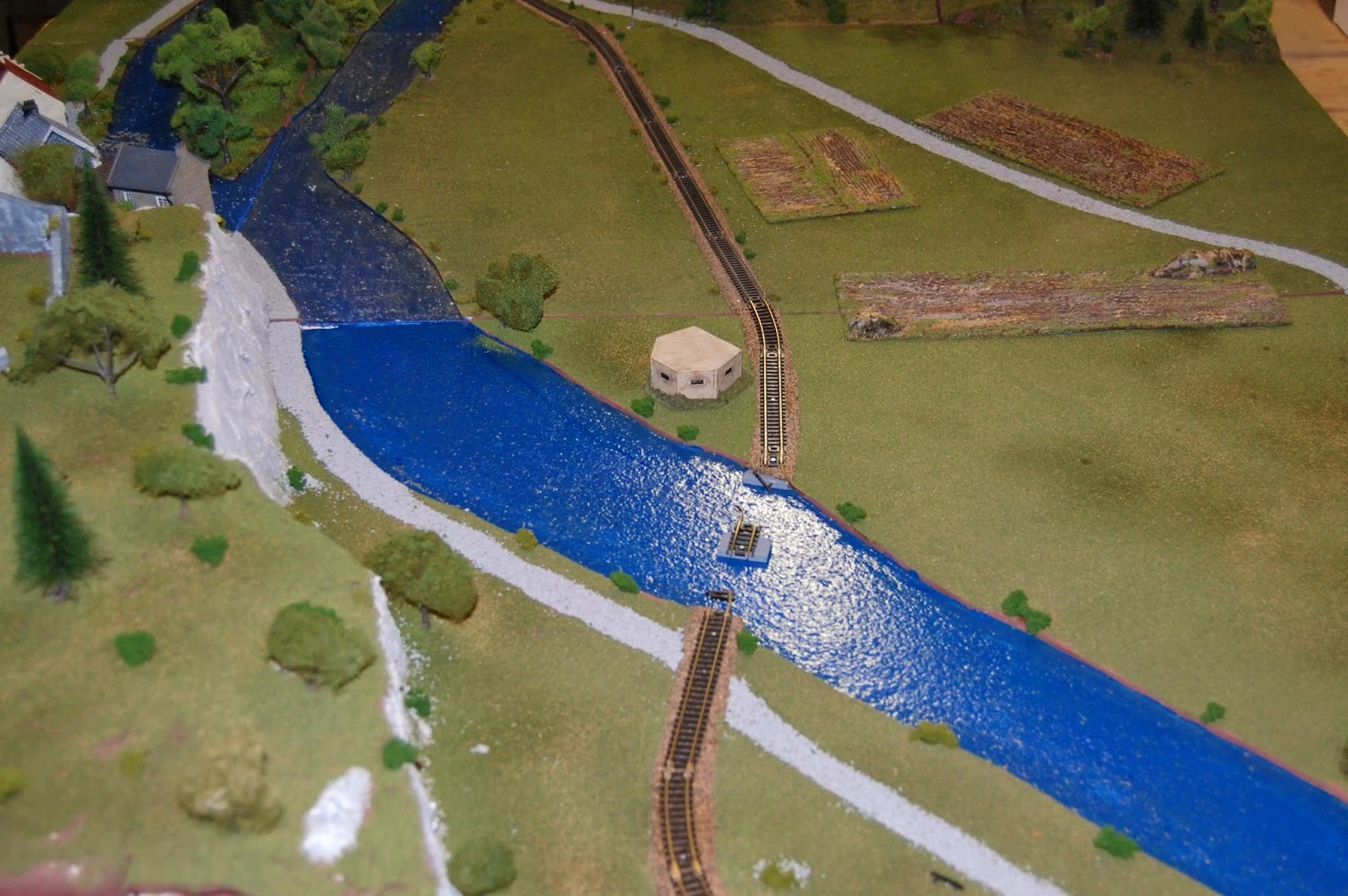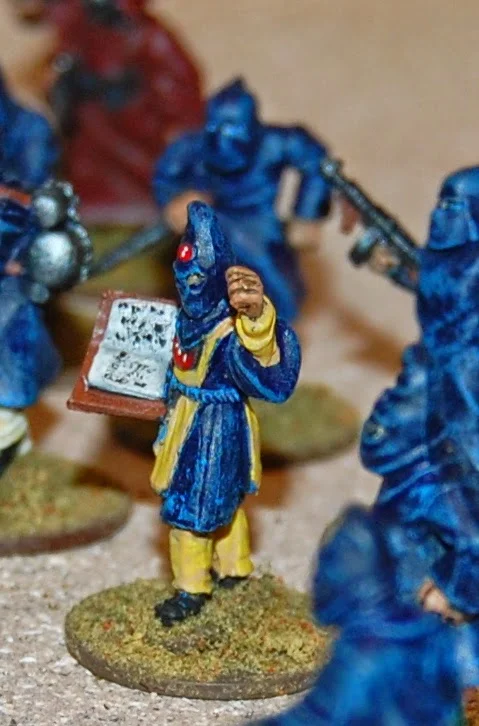To begin our tour, we see the Cairn raised for the officers killed at Killicrankie in July 27, 1689. The Jacobites were lead by Viscount "Bonnie" Dundee, while William's forces were commanded by Major General Mackay. A farmer living on this very ground, has kindly allowed a small fenced walkway (very muddy in spots I will say) to cross the battlefield approximately right down the middle (along with a major highway I might add!).
While Mackay placed his army in a rather difficult position (downhill from the Highlanders, with a river to his back and a small pass as his lines-of-communication) Dundee placed his men in an excellent spot to charge down at his enemies, utilizing the Highlander's chief tactic: a ferocious charge to reach melee. He even had his army wait patiently for the sun (which was in his men's eyes initially) to set so they could see their enemies!. They charged from right to left in this photo. The Cairn is in the right background. Mackay's men were slaughtered in about 20 minutes. Out of an initial 5000 or so men, Mackay reached Stirling with only 500. 2000 may have died on the field, while another 500 perished in the rout. 2000 simply vanished! Jacobite losses amounted to at least 700 who fell at the first volley of the government troops. Tragically for the Jacobites however, "Bonnie" Dundee was mortally wounded at the final volley Mackay's troops managed.
Following their victory at Killiecrankie, the new Jacobite commander was much more cautious, taking until August to push out of the Highlands towards Perth in the South. Somewhere between 500-1000 soldiers were commanded by Colonel Cleland representing the government. The Jacobites had several thousand men led by Colonel Cannon, leader of the small Irish Regiment sent from France. At Dunkeld (only a few miles down the pass from Killiecrankie), the small band of government troops successfully held off attack after attack on August 21. The Highland Army retreated back into the mountains and went home. The Rebellion was all but over! The photo above shows the village square which the small body commanded by Cleland, barricaded for their seemingly hopeless stand!
The next attempt to restore James to the English throne occurred in 1715. This is not the place to attempt to describe the muddled attempts at organizing this revolt. Suffice it to say another Highland army was raised, led this time by the Earl of Mar, "Bobbing Mar". The government forces were led by a Scottish Duke, he of Argyll, head of the largest branch of Clan Campbell. The fight was on a desolate moor called Sheriffmuir, Nov 13, 1715. The Cairn above remembers that day
This view is towards the south and the forces of Argyll. There were no trees in 1715, so the appearance of the foreground would have stretched into the distance towards Stirling in the south. The battle was a strange one, with both sides defeating their enemies right wing, wheel and face each other at right angles to their original positions. But Mar (not a very good leader I might add) was a beaten man, and retreated, ending this uprising.
The next chapter is unique in that it involved a small force of Spanish troops landed in the Highlands to aid in the 1719 uprising. Again, there is much more to the story then I want to speak on here. What you see above, the Glenshiel, a few miles east of the Isle of Skye and the coast. The Marquis de Tullibardine (an exiled Scotsman) led some 1200-1600 Highlanders, even though he personally believes the men should go home and he with the Spanish return to the Continent. The Government forces numbered some 1286 men lead by General Wightman. His forces advanced down the Glen from the background towards a very strong Jacobite position. Lord Murray had detached a few hundred men to the summit on the right foreground, while the remainder of the Highlanders (inc Rob Roy and his MacGregors) stationed themselves on the slopes to the left. The Spanish were positioned in the center, from which this photo was taken. But Wightman had small coehorn mortars to blast away at the Jacobites, and while they were entrenched, could not respond. First Murray's men were driven off, then the Highlander's on the left. The Spanish troops maintained their position and then retreated up the hill that now bears their name: Sgurr nan Spainteach, Peak of the Spanish, where they surrendered the next day. Revolt over.
This is the view of the government troops towards the Spanish position marked by the stones on the crest. Standing there I could not imagine, trying to attack up that slope!
And now to the final chapter of these sad tales; the '45. In 1745, the Old Pretender, James III sent his son, Charles Edward Stuart to raise the country against the Hannover King George. Successfully landing on the western coast of Scotland with only seven men, the young Prince (age 25) convinced some of the Highland Chiefs to call out their men. They quickly captured Edinburgh, then advanced against a government force led by General Cope at Prestonpans, a few miles east of the Scot capital.
The Cairn remembers that engagement. At least there was a sign nearby aiding me in locating this site.
The view is from a large mound just south of the main portion of the battlefield. On Sept 21, The troops of Cope, numbering some 2400, were located to the left center, separated from the Jacobites by a marsh (where the trees now stand). The Scots, commanded by Lord George Murray, with about 2500 Clansmen, marched through the marsh that night and took position on the right. At dawn they charged, and to make a short story even shorter, they broke the government troops in minutes! A grand start to the '45. That is the Firth of Forth in the background.
Having invaded England, and reaching Derby, some 100 miles short of London itself, all but the "Bonnie Prince" advised retreat. They believed they were being surrounded by some 30,000 troops. With only 5000 at his disposal, Murray convinced the Prince to retreat to Scotland. At Falkirk Muir, on Jan 17, 1746, they met the forces of General Hawley. This Monument is the only marker to this battlefield. Most locals I talked to didn't even know it was here!
With a raging thunderstorm overhead, the Highlanders charged from right to left after stopping an initial Hannoverian cavalry charge. Totally breaking the left flank of Hawley's forces they took his cannons, but allowed his right flank, which was protected by a steep burn, to retreat from the field. The Scots continued it's retreat into the Highlands
In February, thanks in part to their captured artillery train, one Jacobite column, forced the surrender of the Ruthven Barracks. It probably helped the the English garrison numbered some dozen men!
The Jacobite Cause, which had tormented Scotland for decades, came to a bloody end here, on Drummossie Moor, some dozen miles east of Inverness. Ignoring Lord Murray's argument that this barren moor was not a place the fight the English cannon and cavalry, "Bonnie Prince Charlie" responded, "God is on Our side"! With some 4000 cold, wet and hungry clansmen against the Duke of Cumberland (the Prince's cousin, and son to King George) and his 7-8000 men with 12 cannon and additional coehorns, it was a slaughter, lasting perhaps an hour. The view above is towards the English lines (marked by red flags) from the center of the Jacobite army. Just as in 1746, this late April day had grey clouds threatening rain, and there was a chill wind blowing in from the east into our faces (as well as the Jacobites)
This trip to Culloden I was able to journey to the southern edge of the moor to look up the burn that led to the right rear of Charlie's army. This is where Cumberland's Campbell soldiers tore down the stone wall so his cavalry could assault the rear of the Jacobite army. The steep slope and desperate defense by his reserves, saved his army from being surrounded.
And what better way to end the tragic story then by viewing the spot where legend has it that the Chief of the MacGillivray Clan, red-haired Alexander of Dunmaglass, after fighting his way through the English lines and half blinded, he crawled to some water, to die face down in that water.
So there you have it, a grand tour of Scottish battlefields. It was immensely satisfying locating each of these sites, especially the more remote and 'lost'. A sad story for a beautiful land and people. If you would like to read further, I highly recommend John Peebles Culloden, still arguably the best on the battle of Culloden. Picked up in Scotland on this recent trip, the book Raise the Clans by Martin Hackett which was fun and useful during my search. It is The Wargamer's Guide to Jacobite Britain and it covers all that I described and more. Hope you enjoyed, and as my forefathers said: "S'rioghal mo dhream"































































